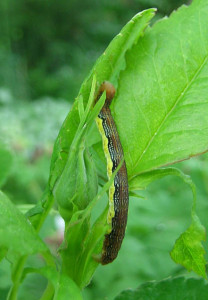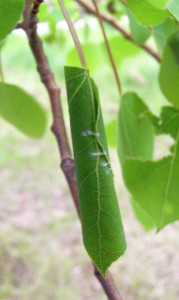
There are many species of caterpillars that feed on tree leaves. Most are specific about what type of tree they feed on, so an outbreak of caterpillars feeding on an elm will likely not defoliate a nearby Schubert Chokecherry for example. Some species feed on a variety of trees and shrubs, as well as herbaceous plants. It is often difficult to identify a caterpillar by species unless it has distinctive markings. Focus on the number of caterpillars and the extent of feeding to assess a problem. Caterpillars all eventually pupate and then turn into butterflies or moths.
Key Points
- Most caterpillars feed on only a few kinds of plants. General defoliation in a garden is extremely unlikely.
- Most caterpillars do not do enough defoliation to warrant chemical use.
- It is difficult to identify most of the thousands of species we have. Focus on the number of caterpillars and extent of feeding to assess a problem.
- A bacterial insecticide that infects only caterpillars called BtK (Bacillus thuringiensis ‘Kurstaki’ can be used to control unusually severe outbreaks.
Tree Damage
All caterpillars chew leaves. Some caterpillars also roll leaves or fold leaves around themselves as protection from predators. These signs, plus silken webbing and black frass (caterpillar feces) are all indications of caterpillar activity.

Some caterpillars are extremely small, at least for part of their lives and may eat from within the leaf, similar to a birch leafminer. There are many species of leaf-mining caterpillars, such as the lilac leaf roller which first mines leaves causing brown patches, and later rolls leaves. Leaf-mining caterpillars cannot be controlled by chemicals, but none does serious damage.
In winter, egg masses, such as those of the spiny elm caterpillar may be found in pathces or rings around the stems of their host trees.
Most caterpillars do not eat enough leaves from a tree to warrant chemical use.


